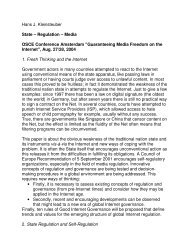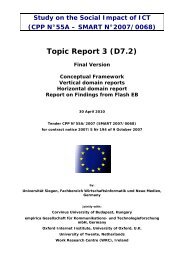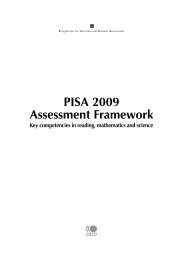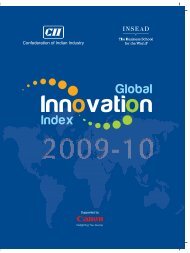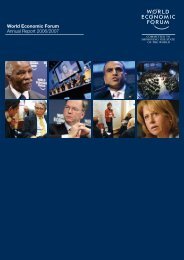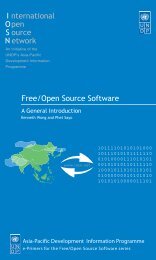You also want an ePaper? Increase the reach of your titles
YUMPU automatically turns print PDFs into web optimized ePapers that Google loves.
22 ❘ FREE/OPEN SOURCE SOFTWARE: LOCALIZATIONAdd 10 computers, office space, Internet connectivity, copy machines and other routine expenses, and arough estimate of the overall cost of localization can be made.Consider the same example with the following change: average experience with software localizationtranslating tools and processes.1. Multiply by 1.0 to reflect average level of experience = 116.65 person-weeks2. Divide by 10 staff members = 11.665 weeks.A project with experienced staff would require less than four months. If the average salary for theseprofessionals is a thousand dollars a month, costs for staff alone is USD40,000.00.Consider the same example with the following change: staff with more experience with softwarelocalization, translation tools and processes.1. Multiply by .75 to reflect above average experience = 81.24 person-weeks2. Divide by 10 staff members = 8.124 weeks.An above average staff of 10 people, requiring no additional training, will need only about two months.If the average salary for these professionals is a thousand dollars a month, cost for staff is onlyUSD20,000.00. Compared to proprietary products, FOSS is ideal for localizing. When a few projects havebeen completed, the costs drop quickly because the underlying concepts and techniques remain thesame. The first few projects must develop new dictionaries, tools and specialties relating to languageand technical processes. The experience of the staff is the key to increased productivity.Once these are in place and well understood, the time and money required to complete additional projectsare reduced. Because FOSS developers tend to adhere to open standards, the developers of a local versiondo not have to reverse-engineer the code to guess what work must be done. The localization processshould be very similar from project to project. With commercial proprietary closed software, the oppositeis true.As we have seen, a major pitfall of proprietary software is that only the owner of the copyright canmaintain or modify it. With FOSS, any person with the appropriate skills can do the work. So, instead ofusers being locked into an expensive maintenance contract with a single foreign vendor, support andmaintenance of software can be <strong>free</strong>ly contracted to a wide variety of local companies.Programmers working alone cannot localize software. When estimating the cost, time and effort requiredfor any localization, set aside only about 10 percent of the budget for technical issues. All the rest goes tothe time-consuming task of translating, writing, testing and training.The Work of LocalizationWhen a proprietary company localizes software, it first determines whether the effort would becommercially viable. Then it hires localization experts, including linguists and cultural experts, to developa technical dictionary. Meanwhile, well-paid analysts and programmers modify the software to acceptand display the script for the language.The lion’s share of localization work involves translating and then replacing the labels, menu items, errormessages and help files of the software. Sometimes the appearance of the software must also be modifiedto fit awkwardly long or short words. The technical dictionary, in some cases, is the first of its kind for thatlanguage, and new terms are invented.Closely following the technical dictionary and programming standards, teams of technical writers enterthe new phrases alongside the English original. When it is all done, testers ensure not only that everymessage has been translated, but also that the terminology is consistent and logical.Work of this sort follows an exponential curve, where the initial work is painfully slow, and then acceleratesrapidly when the technical dictionary and standards are well established. After a few programs havebeen localized, an experienced team can localize additional software at greatly reduced costs. Marketingand training determine how successful they are in getting users to adopt the software. Often, they publishtheir technical dictionaries and standards, selling them for a profit or making them available <strong>free</strong> ofcharge to governments, universities and the online community.



